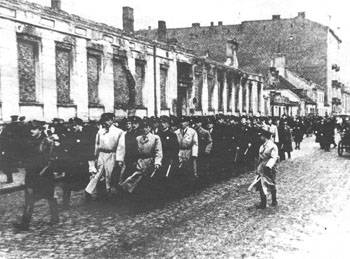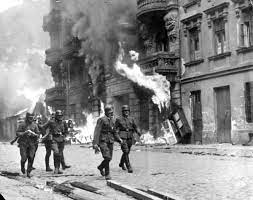The Warsaw Ghetto in April-May 1943 – uprising or police operation?

Each year, around April 19, the media commemorate what they call the Warsaw ghetto “revolt”, “uprising” or “insurrection.” In journalists’ accounts the affair tends to take on increasingly epic and symbolic proportions.
“There was never any insurrection”.[1] This rejoinder, now five years old, is by Marek Edelman, who was one of the main leaders of the ghetto’s armed Jewish groups. He added: “We didn’t even choose the day; the Germans imposed it by entering the ghetto to search for the last Jews”. He specified that the number of Jews who took up arms and fought never exceeded 220.
There was no insurrection of an entire community to gain its freedom or to resist deportation; there was merely the reaction of a handful of young Jews who, seeing the German troops penetrate their sanctuary, tried first to oppose them then, on the third day, attempted to flee and, finally, once surrounded, defended themselves with their weapons. In twenty days of skirmishes the Germans and their auxiliaries would lose fifteen men.[2] The entire matter was more a police operation in the midst of a war rather than a true insurrection like that launched in August 1944 in Warsaw by the Polish resistance fighters of the Home Army under General “Bor” Komorowski. However, the media scarcely, if at all, mark that heroic Polish insurrection, which the Soviets allowed the Germans to crush at their leisure. The men of the resistance fought with such courage that, after their surrender, the German troops accorded them military honours.
It is not without interest to know why the Germans decided to begin a police operation inside the Warsaw ghetto in April 1943.
The Jews grouped in that “ghetto” or “Jewish quarter” made up an officially registered population of 36,000 along with, in all probability, more than 20,000 clandestine residents. The ghetto was, in a sense, a city within the city, administered by a Jewish Council (Judenrat) and a Jewish police force, both of which collaborated with the occupation authorities, including against the Jewish “terrorists”. Following the first Soviet aerial bombardment of Warsaw in 1942, air-raid shelters had been built on German orders, the Germans supplying the Jews with the cement and other materials needed for such structures in their quarter. It is those shelters which legend has transformed into “blockhouses” and “bunkers” comparable to the casemates of the Maginot Line.
Workshops and factories with Jewish personnel operated there, supplying the Germans. Intense trade activities went on within the ghetto. Small armed groups, numbering no more than 220 persons, whose programme comprised the use of “terror and sabotage”, carried out exactions on the Jewish police, Jewish Council and workshop and factory guards.[3] These “terrorists” also profited from the ghetto’s industry and trade, racketeering against merchants and other residents with threats and blackmail, going so far as to sequester them in their homes to obtain ransom money; they even managed to buy weapons from soldiers who, in Warsaw as often in places removed from the front, constituted a disparate, ill-trained, poorly motivated corps. They also succeeded in committing murderous attacks against German servicemen or Jewish “collaborators”.
There was growing insecurity. For this reason the Polish population as a whole was more and more hostile to the ghetto’s existence, and the Germans, for their part, feared lest it become a threat to the city’s important role as a rail hub in the German war economy and for the transport of troops towards the Russian front.
Himmler then took the decision to transfer the Jewish population, with the workshops and factories, to the Lublin region (in the south of Poland) and to raze the ghetto and create a park in its place. At first the Germans tried to get the Jews to agree to this transfer. But the “terrorists” were not interested, for relocation would mean the simultaneous loss of their financial resources and freedom of movement. They therefore put all their energy into opposing it, until April 19, 1943 when, on Himmler’s order, a police operation was begun to evacuate the remaining Jews by force.
On that day the troops of colonel Ferdinand von Sammern-Frankenegg, head of the operation, entered the ghetto, supported by a lone tank – captured during the French campaign – and two armoured cars. Initially the “terrorists” or snipers offered rather stiff resistance, wounding 12 men (six Germans and six back-up soldiers, known as “Askaris”).
Himmler, ever keen to avoid casualties, was indignant and that same evening relieved von Sammern-Frankenegg of his command, replacing him with general Jürgen Stroop. Stroop, instructed to carry out the operation slowly in order to ensure greater safety, did so in the following manner: each morning the troops would enter the ghetto, clear buildings of their occupants and use smoke bombs (and not poison gas!) to drive out the Jews hiding in air-raid shelters; once evacuated, the buildings were destroyed. Each evening the troops withdrew and sealed the ghetto for the night so that no-one could escape.

Jewish police of the Warsaw ghetto pass in review.
The operation to effect full evacuation lasted 20 days. From the third day groups of armed Jews began trying to escape only to find themselves trapped. Contrary to certain accounts, the German command did not call on the Luftwaffe to destroy the ghetto and the operation involved no aerial bombardment.
The number of Jewish dead is unknown, the oft-cited figure of 56,065 being, in fact, that of the Jews apprehended and taken to the transit camp at Treblinka and from there to Lublin.[4] The number of German deaths – let us repeat – was 15. A Polish policeman was killed on May 19, i.e. 11 days after the last skirmish.
Neither the courage of the Jewish fighters in the ghetto nor the tragic nature of the whole affair – with a civilian population itself caught in the midst of combat between a few disparate German army units and small scattered groups of snipers – is to be called into question. But, contrary to a certain growing propaganda, the entire matter was far from amounting to an “apocalyptic” revolt, as it has recently been termed[5], especially if the tens of thousands of deaths, civilian and military, that occurred during those same 20 days on all the battlefields of the planet and in the European cities subjected to Anglo-American bombardment are borne in mind.[6]
_________________
Notes
[1] Libération, April 18, 1988, p. 27.
[2] Nuremberg document PS-1061 dated May 16, 1943: “Report: ‘The Warsaw ghetto is no more’ [Es gibt keinen jüdischen Wohnbezirk in Warschau mehr!]”, International Military Tribunal (IMT), Vol. XXVI, p. 628–693, followed by a selection of 18 photographs (from 52 overall). In 1979 a book presented as a facsimile reproduction of that report and of general Stroop’s communiqués, in German with English translation, was published in the United States: The Stroop report: The Jewish quarter of Warsaw is no more! (Pantheon Books, New York, un-numbered pages). The Warsaw ghetto was “open” despite the perimeter wall; thus it would doubtless deserve the designation “Jewish quarter” rather than ghetto. The actual skirmishes lasted from April 19 to May 8, 1943, i.e. for 20 days.
[3] On these points and on a good many others see Yisrael Gutman, The Jews of Warsaw, 1939–1943: Ghetto, Underground, Revolt, and, in French, Il y a 50 ans: le soulèvement du ghetto de Varsovie (“Fifty Years Ago: The Warsaw Ghetto Uprising”). The latter includes the reprint of an article by Adam Rutkowski published in 1969 under the title “Quelques documents sur la révolte du ghetto de Varsovie” (“Some documents on the Warsaw ghetto revolt”), p. 160–169. On page 162 appear the “general directives for combat of the Jewish Combat Organisation” (JCO), calling for “actions of terror against the Jewish police, the Judenrat, the Werkschutz [protection service for factories and workshops]” and specifying “The military staff prepares the central plan of action – sabotage and terror – directed against the enemy”.
Y. Gutman’s book describes the methods employed by this organisation, which seem hardly different from those of a mafia (p. 344-349). The Germans knew they faced a determined opponent. They sought to persuade the Jews to let themselves be transported to the Lublin area together with the workshops operating for the German war machine. In March 1943 a curious “battle of wall posters” took place between the JCO and Walter C. Többens, the man in charge of evacuating the Jews. JCO posters appeared calling for the rejection of transfer to what they termed death camps. The Germans left these posters in place, going no further than to put up beside them posters signed “Walter C. Többens” in which the JCO’s claims were refuted point by point. Y. Gutman writes: “Többens told the truth about these transports; they weren’t to death camps, and it is a fact that there were buildings for integrating the factories [in the Lublin region]. But at the time the resistance and the suspicions of the Jews were so strong that even the most ingenious tactics weren’t able to overcome them” (p. 334-335). It was after having noted the failure of their methods of persuasion that the Germans decided on a police operation.
[4] “After the people had been taken out of the Ghetto — they numbered between 50,000 and 60,000 — they were brought to the railway station. The Security Police [Sicherheits-polizei] had complete supervision of these people and were in charge of the transport of these people to Lublin” (affidavit of Jürgen Stroop read on April 12, 1946 by an American prosecutor of the Nuremberg Tribunal, IMT, Vol. XI, p. 355.
[5] “The terrible, exemplary, and apocalyptic revolt of the inhabitants of the Warsaw ghetto is at once an act of despair and of heroism” (D. Desthomas, La Montagne, April 17, 1993, p. 12).
[6] The media of the whole world strive to magnify “the Warsaw ghetto uprising”. In Brazil a revisionist periodical has recently made a comparison between the press’s exaggerations and inventions on the subject and the actual facts (S. E. Castan, “Documento: A Verdadeira História do Levante do Gueto de Varsóvia”, Boletim-EP (Esclarcimento ao Pais), June 1993, p. 7–14. Address: Revisão Editora Ltda, Caixa Postal 10466, Porto Alegre, RS, Brazil.

